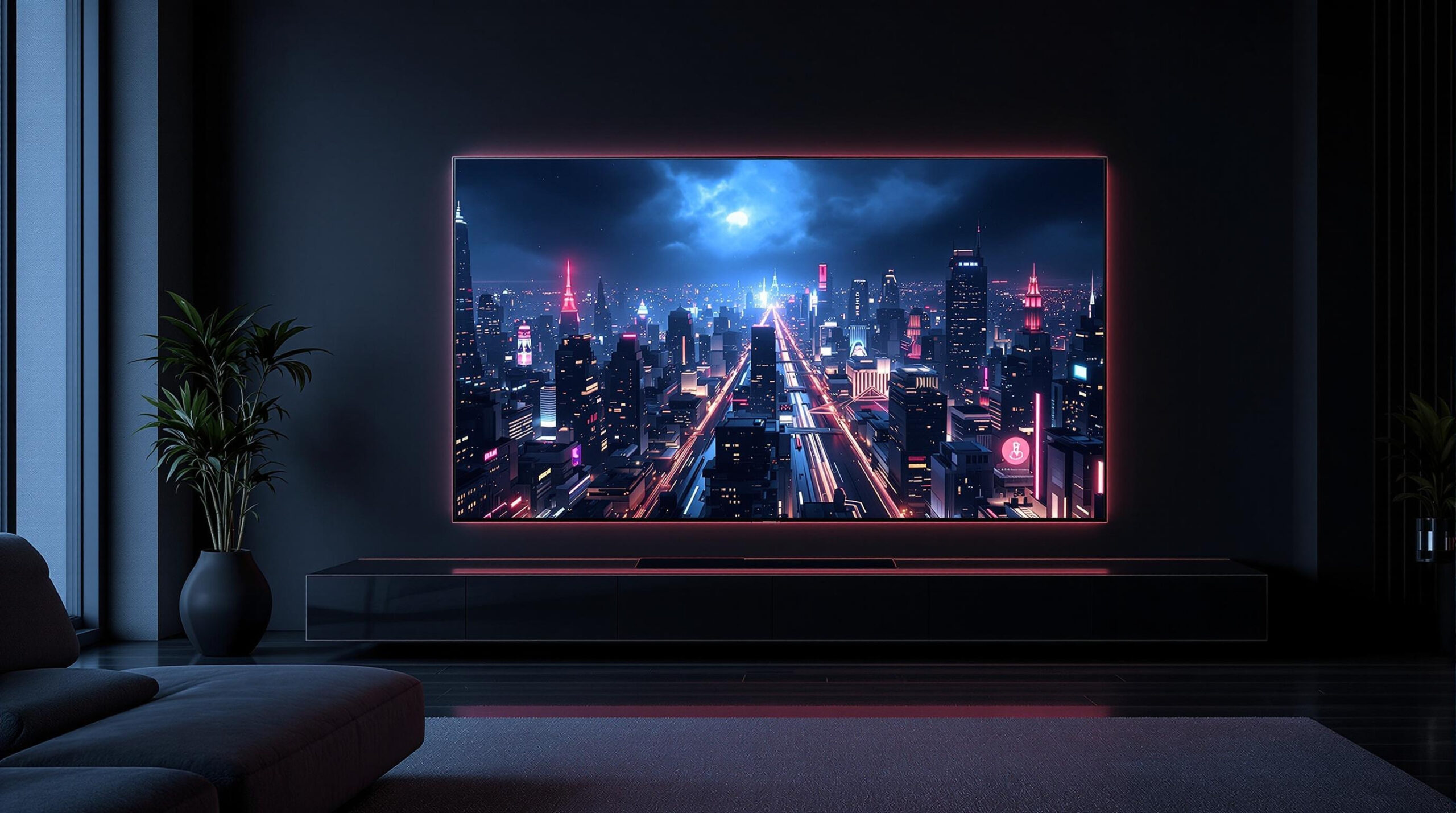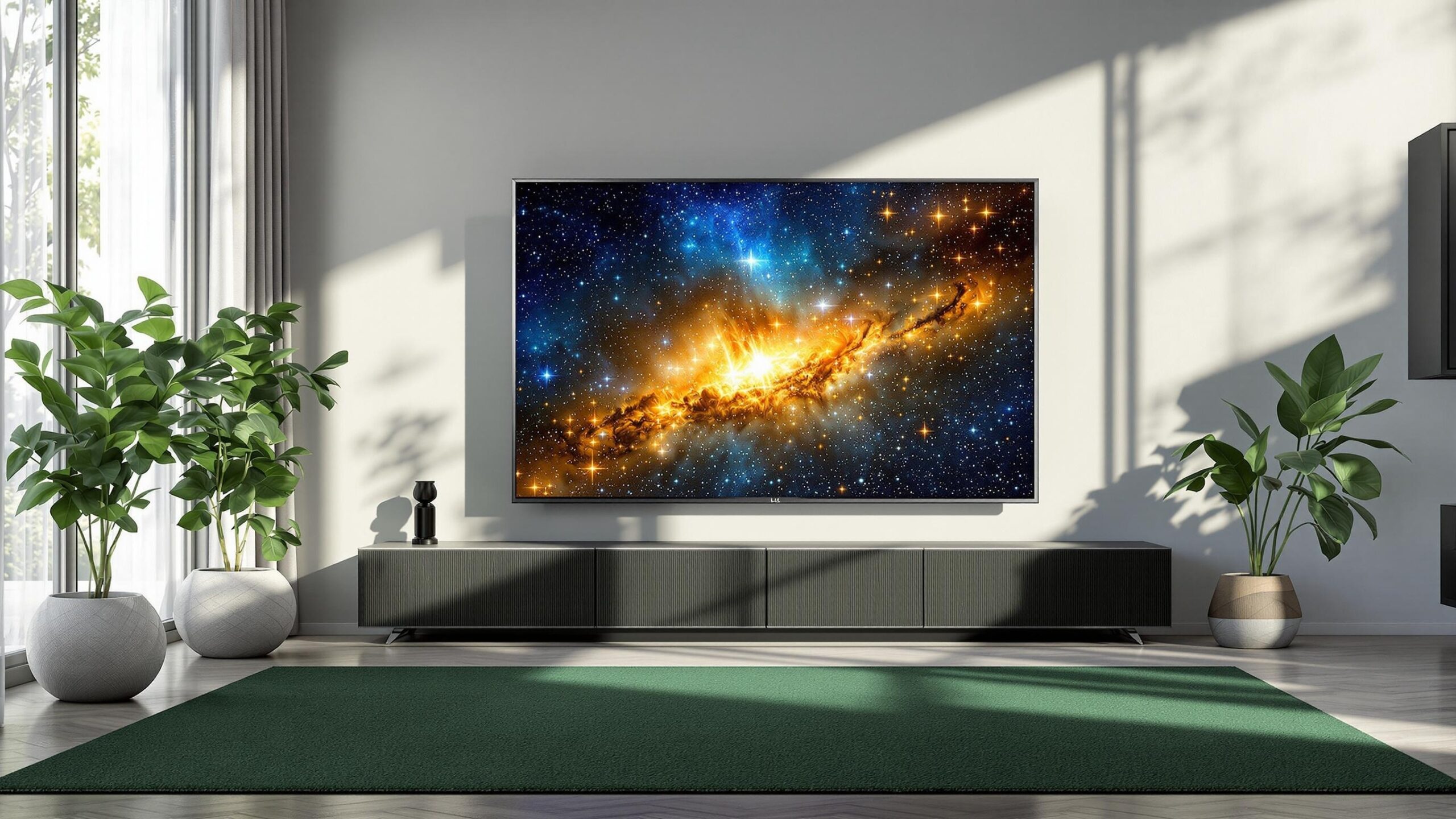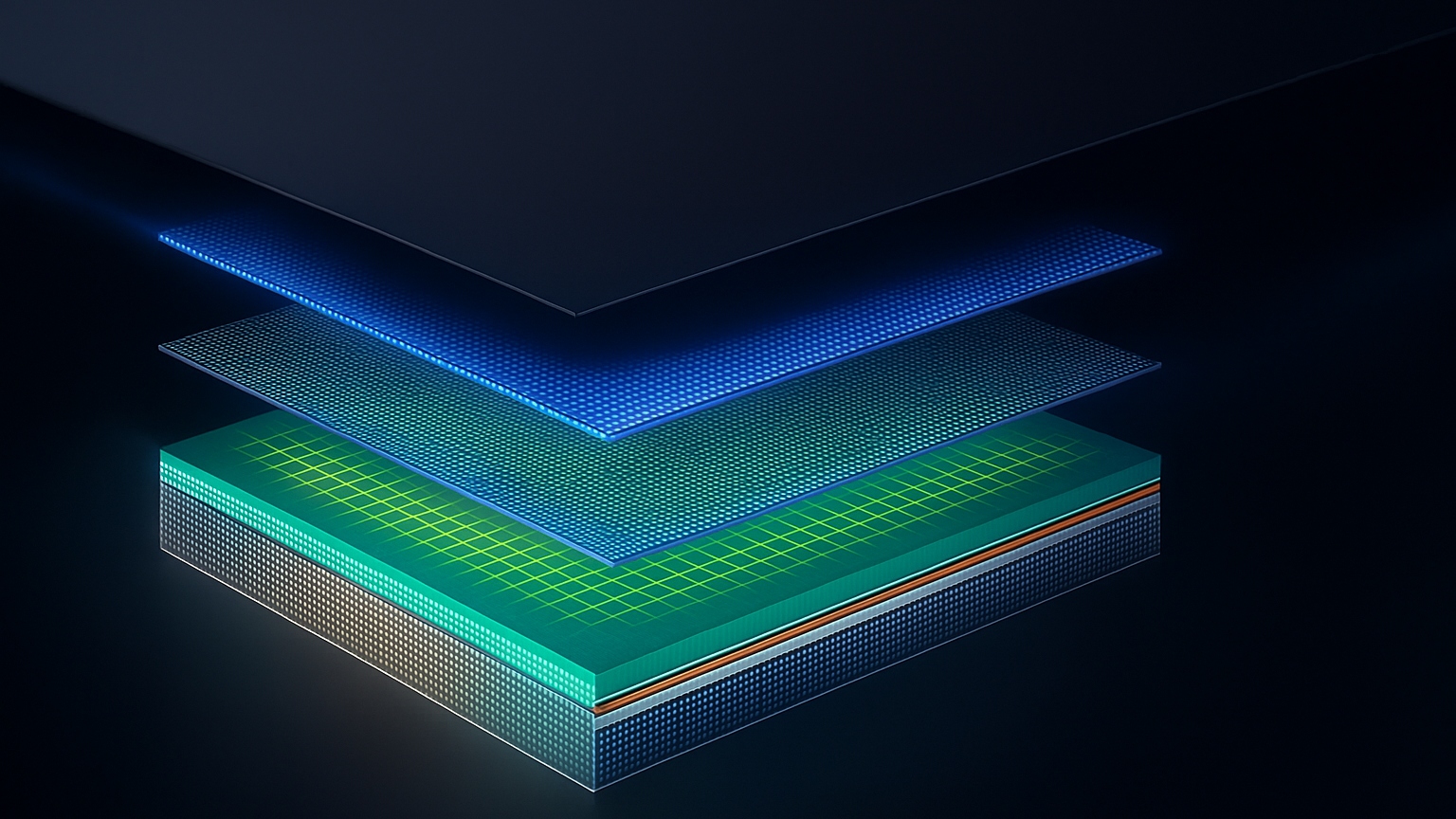Quantum Dot technology has revolutionized the way we experience home entertainment, and QLED TVs have become the go-to choice for those who want stunning brightness, bold colors, and premium features. Unlike OLED, which focuses on perfect blacks, QLED delivers jaw-dropping vibrancy and holds its own in bright rooms, making it ideal for a wide range of environments. Whether you’re a sports fanatic, a cinephile, or a casual viewer who wants a future-proof upgrade, this list of the Top 10 Best QLED TVs will help you find the perfect screen for your setup. Ranked based on picture quality, smart features, value, innovation, and user satisfaction, each entry includes a 600-word breakdown packed with insights, pros and cons, fascinating history, and what makes each TV stand out.
#1: Gold Award: Samsung QN90D Neo QLED ($$)
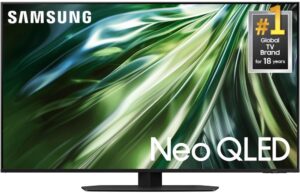
The Samsung QN90D Neo QLED is the crown jewel of Samsung’s 2024 lineup and arguably the most advanced QLED television on the market. With its Mini LED backlighting, it offers an exquisite balance between brightness and precision that few competitors can rival. It’s available in a wide range of sizes—from 43 inches to a cinematic 98 inches—but the 65-inch model hits the sweet spot for most homes. The Quantum Matrix Technology powers this TV’s incredible local dimming, allowing for deep blacks and eye-searing highlights even in sunlit rooms. Neo QLED isn’t just marketing fluff; it’s Samsung’s proprietary implementation of Mini LED that uses thousands of tiny lights for ultra-fine control.
One of its strongest assets is its anti-reflective coating and Ultra Viewing Angle technology, which ensures great visibility from nearly any position in the room. Gamers will rejoice at the inclusion of four HDMI 2.1 ports with support for 120Hz at 4K, AMD FreeSync Premium Pro, and VRR (Variable Refresh Rate). The Motion Xcelerator Turbo+ technology reduces blur and makes high-speed gaming and sports feel unbelievably fluid. Samsung’s Gaming Hub interface even allows for cloud gaming directly from the TV—no console required.
On the smart front, the Tizen OS powers the interface with smooth navigation, app-rich content, and smart assistant support including Alexa, Google Assistant, and Samsung’s own Bixby. It even integrates with SmartThings, turning the TV into a hub for your smart home. Pros include unmatched brightness, excellent gaming features, and versatile smart integration. The cons? The price is steep, especially for larger models, and while the local dimming is fantastic, it can’t completely replicate OLED’s infinite contrast in some very dark scenes.
Historically, Samsung first introduced QLED technology in 2017 as a rival to LG’s OLED dominance. The Neo QLED line debuted in 2021 and has improved every year since, with the 2024 QN90D representing the most refined execution yet. What makes this model particularly fascinating is its sustainability focus. Samsung incorporated recycled ocean-bound plastics into the remote, which recharges via ambient light—no more batteries.
Another cool fact: the QN90D can detect surrounding light and automatically adjust brightness and tone for optimal comfort. This Adaptive Picture feature feels almost like having a film technician in your living room. Combined with Dolby Atmos audio support and Object Tracking Sound+—which makes the audio follow on-screen motion—the immersion is next-level.
In conclusion, if you’re seeking the best of what QLED can offer without stepping into OLED territory, the Samsung QN90D is the gold standard. It’s not just a TV—it’s a statement piece that fuses elegance, power, and smart functionality into one of the most dynamic viewing experiences money can buy.
330+ user ratings with an average of 4.3
#2: Silver Award: TCL QM8 QLED 4K TV (2024)($$)

The TCL QM8 is the TV that’s disrupting the premium QLED space by offering elite-level performance at a fraction of the cost of Samsung or Sony. For the 2024 release, TCL doubled down on performance by enhancing its Mini LED backlight system and delivering nearly 2,000 nits of peak brightness—one of the brightest TVs you can buy today. With support for up to 2,300 local dimming zones in the 85-inch model, this television competes with, and in some ways exceeds, pricier flagship models when it comes to HDR impact.
TCL’s Quantum Dot technology is showcased beautifully here, offering deep, rich reds, vibrant greens, and overall jaw-dropping saturation. The 120Hz native panel supports both Dolby Vision IQ and HDR10+, making this a dream TV for cinema lovers. The motion clarity is exceptional, and for fast-paced sports or action films, the 120Hz refresh combined with TCL’s Game Accelerator 240 (up to 240Hz VRR) gives it a serious competitive edge. Gamers also benefit from HDMI 2.1 support and a dedicated Auto Game Mode.
What’s particularly attractive about the QM8 is its built-in subwoofer. That’s right—this TV features a powerful speaker setup in the back of the panel, giving it real bass response without requiring a separate soundbar. This makes a huge difference when watching epic action scenes or playing immersive games. While audiophiles may still prefer dedicated surround systems, the QM8 gets surprisingly close to an all-in-one solution.
The TV runs on Google TV, offering access to thousands of apps, built-in Chromecast, Google Assistant voice search, and even personalized content recommendations. It’s also compatible with Alexa and Apple AirPlay, making it flexible for smart home users. In terms of drawbacks, some users report occasional blooming around subtitles in very dark scenes, a common side effect of aggressive local dimming. The TV is also heavier than most due to its extensive backlight system and internal subwoofer, so mounting it requires extra caution.
A bit of history: TCL, a company that started making cheap TVs in the early 2000s, has rapidly evolved into a dominant force in the mid-to-premium market, especially in North America. The QM series is their boldest and most refined effort yet, proving they’re no longer just the “budget brand” alternative. The 2023 QM8 was already impressive, but the 2024 update brings more dimming zones, better peak brightness, and improved picture tuning—making it a serious threat to traditional leaders.
One quirky feature that’s getting a lot of attention is TCL’s inclusion of an ambient light sensor that adapts not just brightness but also gamma and color tone to your room’s lighting conditions. That means the QM8 delivers a calibrated-like picture experience right out of the box with minimal tweaking. Add to that a remote with backlit buttons (finally!) and a near bezel-less design, and you have a package that feels far more premium than its price tag suggests.
If you’re looking for the best bang-for-your-buck QLED TV and want performance that rivals $2,000+ sets for significantly less, the TCL QM8 should be at the top of your shortlist. It’s not just good for the price—it’s flat-out one of the best QLED TVs available today.
260+ user ratings with an average of 4.3
#3: Bronze Award: Hisense U8N QLED 4K ULED Mini-LED TV($$)
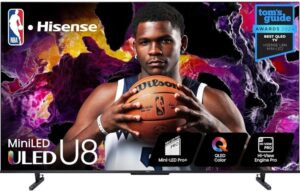
The Hisense U8N is the 2024 successor to the highly praised U8K, and it solidifies Hisense’s reputation as a brand that punches far above its weight. The U8N delivers a blistering peak brightness over 3,000 nits in HDR mode—an absolutely astonishing figure even among QLEDs—and combines that with over 1,600 local dimming zones for truly elite contrast and detail. This is a Mini LED beast wrapped in a sleek frame that feels at home in any modern living room.
From a picture standpoint, the U8N excels with Quantum Dot color, reaching a wide gamut that competes directly with Samsung’s best. Hisense includes support for all major HDR formats, including Dolby Vision, HDR10+, HLG, and even IMAX Enhanced, ensuring your content looks as intended regardless of the source. Motion handling is responsive and fluid, making it perfect for sports and gaming alike.
Gamers will appreciate the full suite of features: 144Hz native refresh rate, two HDMI 2.1 ports, VRR, ALLM, and FreeSync Premium Pro. It’s also among the rare TVs that can natively hit 144Hz in PC mode without sacrificing image clarity—a big win for desktop gaming or next-gen console users. The Hisense Game Mode Pro is smooth, quick, and wonderfully responsive.
Smart features run on Google TV, offering an intuitive UI, strong voice integration, and content aggregation across platforms like Netflix, Hulu, Disney+, and HBO Max. The remote control even includes a dedicated button for Google Assistant, and built-in Wi-Fi 6E keeps your streams silky smooth, even in crowded networks.
However, the U8N isn’t flawless. Black levels, while impressive, can sometimes exhibit slight blooming in the darkest of scenes—though significantly less than most similarly priced competitors. Viewing angles are decent but not amazing; off-axis performance dips a little compared to Samsung’s Ultra Viewing Angle tech. Also, while the built-in speakers are serviceable, they lack depth and presence for home theater aficionados.
Hisense’s ULED branding is their premium take on QLED, and while the name is less known than Samsung or Sony, the technology is no slouch. The U8N represents the culmination of years of aggressive innovation by Hisense, a Chinese electronics titan that has exploded onto the global scene in the past decade. Since their early partnerships with Sharp and Toshiba, Hisense has carved out a space as a serious alternative to the mainstream giants.
Fun fact: the Hisense U8N uses AI-based scene recognition to analyze content frame-by-frame and adjust color, contrast, and motion handling in real time. This automatic scene optimizer is designed for people who don’t want to spend hours calibrating their TV—but still want near-reference quality visuals.
With the U8N, Hisense delivers a genuinely thrilling, high-performance QLED experience that caters to tech-savvy users, gamers, and movie lovers alike—all without emptying your wallet. It’s one of the most exciting QLED releases of the year and easily deserves a top-three ranking.
770+ user ratings with an average of 4.2
#4: Sony Bravia XR X95L Mini LED 4K QLED TV($$$$)
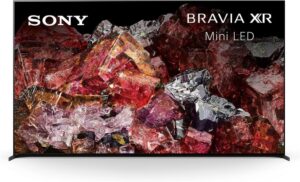
Sony’s Bravia XR X95L is a spectacular example of what happens when high-end QLED hardware meets Sony’s legendary processing expertise. This Mini LED QLED TV doesn’t just aim to match competitors—it aims to surpass them with superior image intelligence, sound clarity, and cinematic realism. Available in sizes ranging from 65 to 85 inches, the X95L serves as Sony’s flagship 4K QLED model, sitting just below their top-tier OLEDs.
What makes the X95L standout is its XR Cognitive Processor—a proprietary chip that analyzes each frame the way the human eye would, prioritizing focus areas and adjusting contrast, depth, and color accordingly. Combined with its Mini LED backlight and precision local dimming, the result is nuanced blacks, exceptional brightness, and a dynamic picture that looks almost three-dimensional.
The picture quality leans toward realism over over-saturation, which makes it especially beloved by cinephiles. With support for Dolby Vision, HDR10, and HLG, movies come alive in rich, natural hues. Motion handling is buttery smooth thanks to Sony’s XR Motion Clarity, which reduces blur without losing detail. The viewing angles are also quite wide—surprisingly so for a VA panel—thanks to Sony’s X-Wide Angle tech.
Gamers aren’t left behind either. With HDMI 2.1, VRR, and 120Hz refresh, the X95L keeps pace with fast action. While it doesn’t push the same gaming-first narrative as Samsung or Hisense, its performance is more than capable. The input lag is low, and it automatically switches to Game Mode with supported consoles like the PlayStation 5.
Audio is another area where Sony impresses. The X95L features Acoustic Multi-Audio+ with tweeters behind the screen that create directional sound, making it feel like dialogue and effects are coming directly from the characters. With Dolby Atmos support, the spatial sound is immersive without needing an external speaker setup.
The Google TV interface is clean and fast, allowing for voice search, app downloads, and personalized recommendations. It also integrates seamlessly with smart homes using Google Assistant or Alexa. Sony’s Bravia Core service even gives buyers access to high-bitrate streaming of blockbuster films—a neat bonus for movie buffs.
Downsides? Price is one. The X95L is not cheap, especially considering competitors like Hisense and TCL offer similar specs for less. Also, while blooming is controlled quite well, it’s still mildly present in certain scenes with small bright highlights on dark backgrounds.
Sony has long been a pioneer in television technology, from the Trinitron CRTs of the ‘70s to the first mass-market OLEDs in the 2010s. The X95L continues this legacy of innovation and polish, delivering a professional-grade image with stunning clarity.
What’s particularly interesting is how Sony uses ambient light sensors and color mapping to adjust picture settings based on room brightness and color temperature. It’s like auto white-balance for your entire living room. Sony even engineered the back of the TV for easy cable management and wall-mount symmetry—little touches that enhance the overall ownership experience.
If you want a premium QLED TV that feels more like an art piece than a gadget, the Sony Bravia XR X95L is one of the best-balanced options on the market. It’s elegant, powerful, and smart—just like you’d expect from Sony.
#5: Samsung Q80D QLED 4K TV ($$)
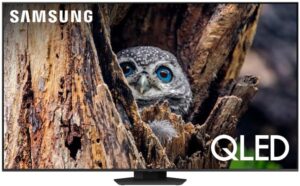
The Samsung Q80D is a perfect middle-ground model for those who want premium QLED performance without venturing into Neo QLED territory. Part of Samsung’s 2024 QLED lineup, this model continues to dominate the upper-midrange space by offering full-array local dimming, Quantum HDR+, and gaming enhancements in a package that balances value with performance.
With a native 120Hz refresh rate, support for HDR10+, and a wide color gamut thanks to its Quantum Dot layer, the Q80D delivers vivid visuals with strong contrast and exceptional color accuracy. The Direct Full Array backlight helps control blooming better than edge-lit competitors, and while it lacks the granularity of Mini LED, it holds its own remarkably well, especially in bright rooms.
The design is sleek and minimalist. Thin bezels, a center-mounted pedestal stand, and an elegantly textured rear panel make this TV aesthetically pleasing from any angle. The 65-inch version remains the most popular size, but it scales well all the way up to 85 inches.
Gamers will enjoy the inclusion of four HDMI 2.1 ports, Free Sync Premium Pro, and Game Motion Plus. With Auto Low Latency Mode and Samsung’s Game Bar overlay, you can see real-time gaming stats, adjust refresh rate, and optimize performance in seconds. Input lag is impressively low, making it a solid option for competitive gaming.
Sound is handled by Samsung’s Object Tracking Sound Lite—a slightly trimmed-down version of their premium spatial audio system. It uses AI to position sound based on on-screen movement, offering a more immersive experience than traditional stereo setups. Dolby Atmos is also supported, though external speakers are still recommended for audiophile-grade sound.
The TV is powered by the Tizen OS, which brings fast navigation, all major streaming apps, and voice control via Bixby, Alexa, or Google Assistant. Samsung Smart Hub remains one of the most stable and user-friendly interfaces in the smart TV space.
Historically, the Q80 series has served as Samsung’s go-to option for consumers who want high-end QLED benefits—like full-array dimming and a 120Hz panel—without the price hike that comes with Mini LED or 8K resolutions. The Q80D continues this mission, offering strong performance without unnecessary fluff.
There are a few caveats. Black levels, while good, don’t match the depth of Neo QLED or OLED panels. And though the sound is decent, it’s not room-filling unless you add a soundbar. Finally, while HDR performance is great for its class, it doesn’t reach the brightness peaks of the QN90D or QM8.
Still, the Q80D shines as a do-it-all QLED TV for families, gamers, and movie watchers alike. Its well-rounded capabilities make it one of the most dependable TVs of 2024.
280+ user ratings with an average of 4.3
#6: Vizio Quantum X QLED 4K TV (P-Series, 2023–2024 Refresh)($$)
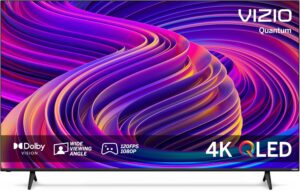
Vizio’s Quantum X P-Series QLED is an underrated powerhouse that consistently flies under the radar despite offering some of the best value in high-brightness home theater. With a peak brightness that reaches up to 3,000 nits and over 200 local dimming zones, this TV competes directly with flagship Samsung and TCL models but at a much lower cost. The image pops in both dark and bright rooms, making it an ideal candidate for living rooms with variable lighting.
Vizio uses Quantum Color technology to achieve wide color gamut coverage—over 85% of Rec.2020 in many tests—and it’s genuinely vibrant. Blacks are impressively deep, and its Full Array Pro backlight ensures more accurate contrast control than most TVs at this price. Gamers will appreciate the inclusion of a native 120Hz panel, HDMI 2.1, VRR, and AMD FreeSync, with ultra-low input lag around 7ms in Game Mode. Vizio’s ProGaming Engine also enhances response times for next-gen consoles.
Where Vizio really shines is brightness—HDR content looks dazzling. Dolby Vision, HDR10+, and HLG are all supported, so no matter your streaming service or Blu-ray disc, you’re getting the full experience. The design is solid, with a minimalist frame and a sturdy metal stand, though it’s bulkier than most.
SmartCast, Vizio’s homegrown OS, powers the interface. It’s functional and improving, with built-in Chromecast, Apple AirPlay 2, and voice control via Alexa and Google Assistant. However, SmartCast has a history of sluggishness, and while it’s smoother now than in past years, it still lags behind Google TV or Tizen in polish.
Historically, Vizio carved a name in the 2000s as a brand that democratized HDTVs by bringing plasma and LCD panels to the masses at lower costs. The P-Series Quantum X was introduced as their flagship for customers who didn’t want OLED but still wanted elite performance. This 2023–2024 model brings Mini LED brightness territory without the Mini LED price.
The main drawbacks? Narrower viewing angles and a less intuitive smart OS. Also, while blooming is managed well, it’s not entirely eliminated in very dark scenes with bright highlights.
Still, if you want a bright, vibrant, affordable QLED TV built for movies, sports, and gaming alike, the Vizio Quantum X P-Series continues to deliver exceptional value.
#7: Samsung The Frame QLED 4K TV (LS03D, 2024 Model)($$)
 amsung’s The Frame isn’t just a television—it’s a piece of living room art. Designed to blend into your decor rather than dominate it, The Frame uses QLED technology with an anti-reflective matte finish that mimics a real canvas when it’s not being used. This makes it perfect for style-conscious homeowners who want a beautiful screen without the typical “black mirror” when the TV is off.
amsung’s The Frame isn’t just a television—it’s a piece of living room art. Designed to blend into your decor rather than dominate it, The Frame uses QLED technology with an anti-reflective matte finish that mimics a real canvas when it’s not being used. This makes it perfect for style-conscious homeowners who want a beautiful screen without the typical “black mirror” when the TV is off.The 2024 model (LS03D) brings performance improvements including enhanced contrast, better brightness control, and a slimmer One Connect Box for easier cable management. The TV uses Quantum Dot color for vibrant picture quality and supports HDR10+, HLG, and Adaptive Picture to fine-tune the image based on room lighting. While it lacks local dimming, the backlight is uniform and bright enough for casual viewing, especially in rooms with lots of ambient light.
What sets The Frame apart is Art Mode. Users can choose from thousands of artworks, photographs, or even upload personal pictures to display when the TV is idle. The auto-sensor wakes the screen only when someone’s in the room, helping save energy. Swappable bezels in a variety of styles—from Modern White to Teak—allow for full aesthetic customization.
Gaming isn’t the Frame’s main focus, but it includes HDMI 2.1, Game Mode, and a 120Hz panel for smooth gameplay. It’s compatible with Samsung’s Game Hub, though the lack of full-array dimming might disappoint competitive gamers seeking pitch-perfect contrast.
Running on Tizen OS, The Frame provides full smart features, app access, voice assistants, and smart home integration. Audio is handled by dual speakers with Dolby Digital Plus and Object Tracking Sound Lite, though audiophiles will likely pair it with a soundbar.
The Frame was first introduced in 2017 as part of Samsung’s lifestyle series. Since then, it has become a cult favorite among interior designers and design-savvy consumers who want form and function in one device. The 2024 model perfects the illusion: people often can’t tell it’s a TV unless it’s on.
If you care as much about how your TV looks when it’s off as when it’s on, The Frame is simply unmatched.
760+ user ratings with an average of 4.1
#8:TCL Q7 QLED 4K TV (2024) ($$)

If you’re after a great mid-tier QLED TV that still feels like a premium device, the TCL Q7 is the one to beat in 2024. Positioned just under TCL’s flagship QM8, the Q7 delivers a compelling balance of performance, features, and affordability. It’s a TV that doesn’t rely on flashy gimmicks but instead focuses on delivering solid hardware, gaming chops, and vivid visuals—all at a price point that makes it accessible to a broader audience. With its Quantum Dot technology, Full Array Local Dimming, and a native 120Hz panel, the Q7 punches well above its weight class.
The panel uses Quantum Dot color technology to deliver richly saturated hues with excellent accuracy, especially for its price bracket. TCL has included up to 200 dimming zones (depending on screen size), which allows for deeper blacks and better contrast than most edge-lit competitors. While it doesn’t employ Mini LED technology like the QM8, the Full Array backlighting system is still highly effective, creating a vivid image with strong contrast in both dark and well-lit rooms. The result is a TV that works well in varied lighting environments—from movie nights in dim rooms to watching daytime sports in sun-drenched living rooms.
The Q7’s real strength lies in its versatility. It’s a true all-rounder that adapts to different content types with ease. Movies and shows benefit from rich color depth and high peak brightness that enhances HDR content, which is supported in Dolby Vision, HDR10+, HDR10, and HLG formats. Sports fans will appreciate the smooth motion, thanks to the native 120Hz refresh rate and effective motion interpolation. But perhaps most impressively, the Q7 is a serious contender in the gaming arena.
Equipped with HDMI 2.1 inputs, the Q7 supports Variable Refresh Rate (VRR), Auto Low Latency Mode (ALLM), and TCL’s Game Accelerator 240, which boosts frame rates up to 240Hz in supported gaming scenarios. This makes it an excellent choice for fast-paced console and PC gaming. Input lag is extremely low—often measuring under 6ms in Game Mode—and VRR support means screen tearing is virtually eliminated. Whether you’re playing first-person shooters or open-world RPGs, the experience feels fluid and responsive.
On the smart side, the Q7 is powered by Google TV, providing a smooth, intuitive interface with robust voice search capabilities and a wide range of app support. Google TV’s content aggregation pulls together personalized recommendations from your streaming subscriptions, reducing the time spent browsing. Voice control is fully integrated with Google Assistant, and it’s also compatible with Alexa and Apple AirPlay. You also get built-in Chromecast for effortless screen mirroring.
Design-wise, the Q7 looks sharp and refined. Slim bezels give it a clean, modern aesthetic, and the chassis feels more premium than many TVs in its price range. A central pedestal stand keeps the setup stable and compact for TV consoles, though it can be wall-mounted with standard VESA mounts for a cleaner look. The overall build quality is solid, and the screen coating does a respectable job of reducing reflections.
In terms of audio, the Q7 is adequate, though it won’t impress audiophiles. The built-in speakers handle dialogue well, and volume output is sufficient for medium-sized rooms. However, the bass response is limited, and complex soundscapes in movies or games don’t feel as immersive. TCL does include support for Dolby Atmos passthrough via HDMI eARC, so pairing it with a capable soundbar or home theater system can significantly elevate the audio experience.
Ultimately, if you want around 85–90% of the performance of a flagship QLED TV without paying flagship prices, the TCL Q7 is a remarkable option. It brings together a fantastic suite of features—high refresh rate, strong HDR performance, low input lag, and robust smart functionality—at a price that makes it hard to ignore. Whether you’re gaming, streaming, or watching sports, this TV delivers a premium experience without the premium cost.
1000+ user ratings with an average of 4.6
#9:Hisense U7N QLED 4K ULED TV (2024) ($$)
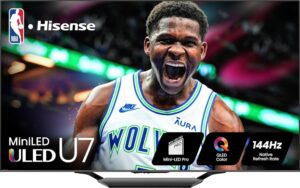
The Hisense U7N is one of the most compelling QLED options for 2024 in the upper-budget to midrange category, offering a fantastic blend of gaming features, high brightness, and picture quality that rivals more expensive competitors. While it doesn’t have the ultra-premium status of its sibling, the U8N, the U7N delivers where it counts—especially for users who want a robust 4K experience with smooth motion, vivid colors, and modern connectivity.
At its core, the U7N is powered by Hisense’s ULED technology, which enhances standard QLED with improved contrast and motion handling. It features Full Array Local Dimming (FALD) with around 120 dimming zones on the 65-inch model—impressive for this price bracket. While it doesn’t include Mini LED, the dimming and backlight performance are well-tuned for most living rooms, delivering above-average black levels and balanced contrast. Peak brightness hits roughly 1,200 nits, allowing HDR content to shine with strong highlights and good specular detail.
Color reproduction is rich and accurate thanks to its Quantum Dot layer, which ensures a wide color gamut—reaching up to 95% of DCI-P3. The U7N supports Dolby Vision, HDR10+, HDR10, and HLG, making it one of the most format-friendly TVs in its class. For movies, especially streaming on services like Netflix and Disney+, the picture is crisp and immersive, with cinematic depth and vibrancy. It’s particularly well-suited for moderately lit rooms and does a commendable job suppressing glare.
Where the U7N really steps up is in gaming. With a native 144Hz panel, support for AMD FreeSync Premium Pro, Auto Low Latency Mode (ALLM), and Variable Refresh Rate (VRR), this TV is built for next-gen consoles and high-performance PC gaming. Input lag is ultra-low—often testing under 7ms in Game Mode—making it ideal for fast-twitch shooters and eSports. Hisense also includes its Game Mode Pro suite, which optimizes image processing specifically for smoother gameplay.
The smart platform is Google TV, offering a clean, modern interface with personalized recommendations and robust voice control. With built-in Chromecast, Google Assistant, and support for Alexa, you’ll have no problem integrating the U7N into a smart home ecosystem. App selection is excellent, and streaming is smooth thanks to dual-band Wi-Fi and Wi-Fi 6E compatibility.
Design-wise, the U7N features slim bezels, a center-mounted pedestal stand, and a brushed metal-like finish that feels premium for its price. It’s mountable and easy to blend into modern décor. Audio is handled by dual down-firing speakers that are serviceable but won’t blow you away. Dialogue is clear, and Dolby Atmos support is present, but if you want cinematic bass or surround separation, a soundbar is still recommended.
The Hisense U7N is part of a growing trend where manufacturers are closing the gap between budget and flagship models. Historically, Hisense has made massive strides in just a few years—transforming from a low-cost player into a global innovator. The U7N is proof of that evolution. It doesn’t overpromise or underdeliver. It simply focuses on what most people need: a bright, colorful 4K display with excellent motion clarity, gaming capability, and smart functionality.
For gamers, casual movie watchers, or anyone wanting a great viewing experience without the premium price tag, the Hisense U7N is one of the best-balanced QLED TVs of 2024.
800+ user ratings with an average of 4.4
#10: Samsung Q70D QLED 4K Smart TV (2024) ($$)
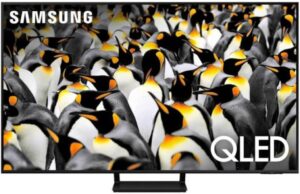
Rounding out the list is the Samsung Q70D, a mid-range QLED TV that continues Samsung’s long-standing tradition of packing smart design, vibrant visuals, and reliable performance into an accessible package. While it sits below the Neo QLED series and lacks advanced features like Mini LED or full-array local dimming, the Q70D still brings solid 4K quality, smooth motion, and a refined smart experience to the table—making it an ideal pick for families, casual gamers, and everyday viewers.
The Q70D features Samsung’s Dual LED backlight technology, which balances warm and cool light tones for better contrast and color accuracy than traditional edge-lit panels. It doesn’t offer local dimming like higher-end models, but it compensates with Quantum HDR, a wide color gamut, and impressive peak brightness for its class—hovering around 800–900 nits in HDR content. That makes it a solid performer in moderately lit rooms, though deep black levels and shadow detail won’t match full-array or OLED displays.
Its Quantum Dot layer ensures that colors remain punchy and accurate, especially when watching vibrant, fast-paced content like sports or action films. HDR10+ Adaptive and HLG are both supported, as is Samsung’s Adaptive Picture feature, which adjusts brightness based on room lighting to improve visibility and comfort.
The real star of the Q70D is its motion handling and gaming performance. The native 120Hz panel supports AMD FreeSync, Variable Refresh Rate (VRR), Auto Low Latency Mode (ALLM), and Game Motion Plus—making this TV responsive and smooth for next-gen consoles. Gamers can expect input lag in the 10ms range and nearly tear-free visuals thanks to the HDMI 2.1 support. Samsung’s Game Bar also makes it easy to tweak settings on the fly without digging through menus.
On the smart side, the Q70D runs the latest version of Samsung’s Tizen OS, which is fast, clean, and loaded with features. It includes Samsung Smart Hub for app streaming, the Gaming Hub for cloud play, and support for Alexa, Google Assistant, and Samsung’s own Bixby voice assistant. The interface is smooth, and multitasking between streaming apps, screen mirroring, and device control is snappy and intuitive.
Audio performance is decent for casual use, with built-in Dolby Digital Plus and Object Tracking Sound Lite. While the sound isn’t as immersive as higher-end models, it’s clear enough for most viewing scenarios. Still, anyone looking for deep bass or spatial sound will benefit from a soundbar.
Visually, the Q70D is sleek and minimalist. Its slim bezels and modern chassis blend seamlessly into any space, and it’s available in multiple sizes—from a modest 55 inches to a cinematic 85 inches—giving you flexibility for different room sizes.
The Q70 series has a strong legacy within Samsung’s TV family, going back several years as a reliable mid-tier workhorse. The 2024 Q70D maintains that tradition, updating connectivity, adding more gaming tools, and refining its smart experience while keeping pricing accessible.
In short, the Q70D is a “just right” TV for many people. It won’t deliver the absolute deepest blacks or highest brightness, but it offers consistent, satisfying performance across the board. If you’re seeking a smart, dependable QLED with great gaming support and a trusted brand name, the Q70D remains a solid choice for 2024.
90+ user ratings with an average of 4.2
Side-By-Side Comparisons
| TV Model | Price Range | Pros | Cons | Backlight Type | Smart Platform | Audio | Resolution | Gaming Ready | Size Options | Notable Feature | |
|---|---|---|---|---|---|---|---|---|---|---|---|
| #1: Samsung QN90D Neo QLED | 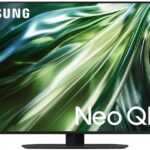 | $$$$ | Exceptional brightness, mini LED, elite gaming features | Expensive, not true OLED black levels | Mini LED | Tizen | Dolby Atmos | 4K | Yes | 43–98” | Ultra Viewing Angle |
| #2: TCL QM8 QLED |  | $$$ | Outstanding value, ultra-bright, built-in subwoofer | Some blooming, heavy design | Mini LED | Google TV | Dolby Atmos | 4K | Yes | 65–98” | Gaming Accelerator 240 |
| #3: Hisense U8N QLED |  | $$$$$ | Extreme brightness, rich colors, 144Hz panel | Minor blooming, average viewing angles | Mini LED | Google TV | Dolby Atmos | 4K | Yes | 55–85” | IMAX Enhanced |
| #4: Sony Bravia XR X95L |  | $$$$$ | Incredible processing, immersive audio | Pricey, limited HDMI 2.1 ports | Mini LED | Google TV | Acoustic Multi-Audio+ | 4K | Yes | 65–85” | Cognitive XR Processor |
| #5: Samsung Q80D QLED | 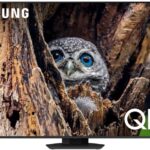 | $$$ | Great all-rounder, bright panel, gaming features | Limited contrast, not Mini LED | Full Array | Tizen | OTS Lite | 4K | Yes | 55–85” | Game Bar 3.0 |
| #6: Vizio Quantum X P-Series | 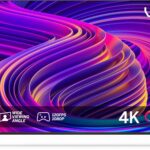 | $$ | Very bright, Dolby Vision, great value | Mediocre smart OS, narrow angles | Full Array | SmartCast | Dolby Atmos | 4K | Yes | 65–85” | ProGaming Engine |
| #7: Samsung The Frame (LS03D) |  | $$$ | Art Mode, matte display, design-focused | Edge-lit, average contrast | Edge-lit | Tizen | OTS Lite | 4K | Yes | 43–85” | Art Mode |
| #8: TCL Q7 QLED |  | $$ | Great motion, 240Hz VRR, solid color | Lacks Mini LED, average sound | Full Array | Google TV | Basic Stereo | 4K | Yes | 55–85” | Game Accelerator 240 |
| #9: Hisense U7N QLED |  | $$$$ | Affordable 144Hz, Dolby Vision, low input lag | No Mini LED, limited sound | Full Array | Google TV | Dolby Atmos | 4K | Yes | 55–85” | Game Mode Pro |
| #10: Samsung Q70D QLED | 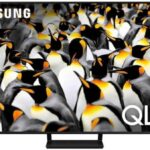 | $$$ | Sleek, 120Hz panel, solid smart features | Edge-lit, weaker black levels | Edge-lit | Tizen | OTS Lite | 4K | Yes | 55–85” | Game Motion Plus |


